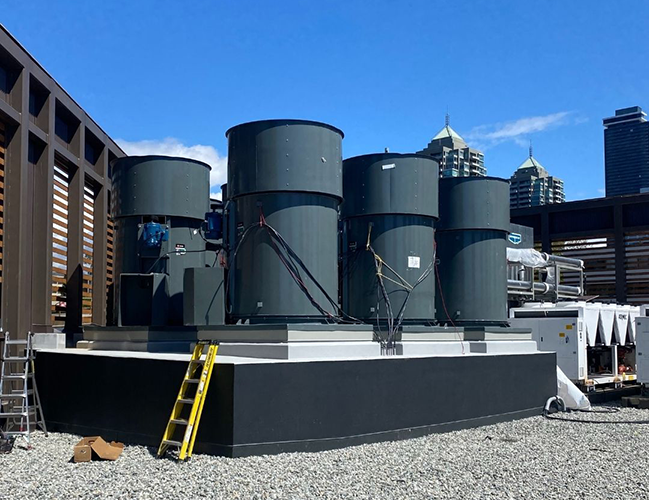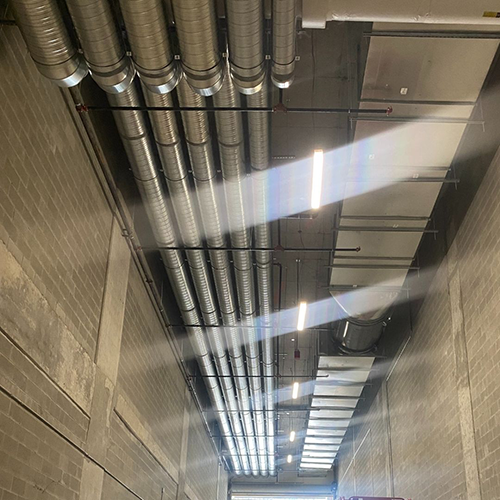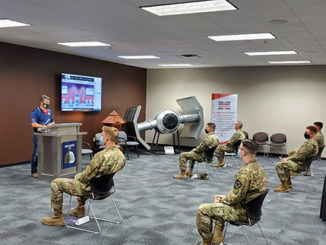
By Natalie Bruckner • Photos courtesy of Evergreen Sheet Metal
The landscape of Burnaby is changing, and nowhere is that more evident than at Gilmore Place. This master-planned community by Onni Group is redefining the city’s western gateway with a bold vision of modern urban living. Featuring one of Canada’s tallest residential towers, direct integration with the Gilmore SkyTrain Station, high-end shopping, entertainment, premium office spaces, and luxury residences, Gilmore Place exemplifies Burnaby’s fast-changing skyline.
As one of the most complex developments ever to be integrated with a SkyTrain station, the mechanical systems required for such a high-density development were integral to its success. Evergreen Sheet Metal played a key role in this, tasked with installing and commissioning the HVAC system—critical for ensuring optimal air quality, ventilation, and climate control across all areas in the three mixed-use towers that comprise Phase One. Their scope covered everything from the parkade and amenities to the individual residential units in all three towers—a massive undertaking that demanded precision engineering and seamless coordination across trades.
“The complexity of Gilmore Place’s HVAC system set it apart,” says Justin Nguyen, project manager at Evergreen Sheet Metal. “The buildings’ design required a deep understanding of HVAC systems and building codes to ensure seamless execution and functionality. Every component had to be meticulously planned to integrate with the structure, ensuring efficient operation for years to come.”
Nguyen explains that the centrepiece of the project is the luxurious, high-end amenities on levels four and five of each tower. “A high-efficiency central AHU provides ventilation for the pool area using aluminum ductwork and continuous linear diffusers, enhancing the space’s elegance,” he explains. “The AHU is located in a restricted crawlspace, posing significant challenges for installation and logistics.”




Evergreen entered the bidding process in late 2020, securing the contract based on their reputation for quality, expertise and problem-solving capabilities. By mid-2021, their team was on-site, ready to tackle one of the most ambitious HVAC installations in Burnaby’s history.
With a project of this scale, execution was far from straightforward. The HVAC system was designed to handle high occupancy while maintaining energy efficiency and regulatory compliance. The installation had to be carefully sequenced with other trades to avoid conflicts and ensure seamless integration into each building’s infrastructure.
“The biggest hurdle was aligning our work with other trades to prevent clashes during installation,” Nguyen explains. “This is a massive project with a complex mechanical system, and a significant amount of planning took place during the design phase. With so many moving parts, even a minor misalignment could lead to costly rework.”
To mitigate these challenges, Evergreen leveraged advanced building information modelling (BIM) software such as Revit and Revizto. These tools allowed the team to create highly detailed 3D models, simulating the entire mechanical system before any physical installation began. By identifying potential conflicts early, Evergreen could make necessary adjustments in the virtual space—long before materials arrived on-site.
“Our use of Revit and Revizto was critical in streamlining the coordination process,” Nguyen explains. “By modelling everything digitally, we minimized the need for on-site modifications and improved overall efficiency.”
Material management was another key factor in keeping the project on schedule and within budget. The COVID-19 pandemic had caused widespread disruptions in the global supply chain, leading to price fluctuations and material shortages. To stay ahead of these challenges, Evergreen implemented a preloading strategy, ensuring materials and equipment were secured well in advance.
“Preloading materials and equipment helped us stay on track, particularly with rising costs across various materials,” says Nguyen. “By planning ahead, we minimized delays and prevented budget overruns.”
Evergreen also leaned heavily on prefabrication techniques. Instead of relying solely on field measurements and manual fabrication, much of the metalwork was designed directly from BIM models and manufactured off-site. This approach not only reduced material waste but also significantly cut down on labour time, enhancing overall productivity.
Sustainability was a major focus at Gilmore Place, aligning with Burnaby’s push toward energy-efficient building standards. The development’s mechanical systems were initially designed to comply with ASHRAE 90.1 2010, a widely recognized standard for energy efficiency in buildings. However, as the City of Burnaby adopted the BC Energy Step Code, the project had to meet even stricter energy performance requirements.
“This was a significant challenge,” says Nguyen. “We needed to source ‘green’ equipment with low energy consumption to align with LEED requirements while maintaining system performance.”
One of the key sustainable features of the project is an ambient loop system powered by air-source heat pumps. “A central make-up air [MUA] unit, working in conjunction with the heat pump system, delivers heating and cooling to approximately 60,000 square feet of amenity spaces. This required an exceptional level of coordination to ensure every duct run was precisely accounted for and carefully measured. With limited pressure drop allowances, we meticulously designed the system to deliver optimal airflow while maintaining superior acoustic performance,” Nguyen says.
Indeed, executing an HVAC installation at this scale requires not only technical expertise but also exceptional problem-solving skills. Every aspect of the system—from airflow optimization to integration with smart building controls—had to be carefully considered.
The sheer scale of the project meant that even small inefficiencies could have significant consequences. By employing high-efficiency air filtration and airflow management systems, Evergreen ensured that Gilmore Place residents would enjoy superior indoor air quality, enhancing both comfort and health.
At its core, Evergreen Sheet Metal thrives on growth—both as a company and as individuals. “Like the evergreens in our name, we believe in continuously learning and strengthening our trade,” Nguyen says. “Projects like Gilmore Place push us to evolve, from coordinating across multiple trades to optimizing designs for efficiency. It takes commitment and dependability from our team to ensure that every piece of ductwork and ventilation system meets the highest standard.”
Beyond technical execution, what sets Evergreen apart is the company’s team-oriented culture. Large-scale projects like this require close collaboration, trust, and a shared commitment to excellence. From apprentices to senior engineers, everyone played a crucial role in delivering a world-class HVAC system that will serve Gilmore Place for decades to come.
Being part of a landmark development like Gilmore Place is more than just another job—it’s a testament to how Evergreen Sheet Metal continues to innovate. With every project, they solidify their reputation as industry leaders, ensuring that buildings not only stand tall but breathe easy. ■



